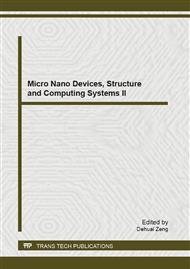[1]
X. Wu and T. Wang: A 3-D Finite Element Resistivity Forward Modelling Using Conjugate Gradient Algorithm. Chinese Journal of Geophysics Vol. 46 (2003), p.428.
DOI: 10.1002/cjg2.3379
Google Scholar
[2]
Z. Liang and R. Tang: Rapid Storage Technique of Coefficient Matrix in Finite Element Method. Advanced Technology of Electrical Engineering and Energy Vol. 23 (2004), p.24.
Google Scholar
[3]
J. Zhou and D. Wang: Exploration on Memory Requirement and Operation Efficiency of Finite Element Method in Flow Calculation. Advances in Water Science Vol. 15 (2004), p.593.
Google Scholar
[4]
S. Yao and H. Tian: Compressed Storage Scheme and Assembly Procedure of Global Stiffness Matrix in Finite Element Analysis. Journal of Central South University (Science and Technology) Vol. 37 (2006), p.826.
Google Scholar
[5]
J. Lu, X. Wu and K. Spitzer: Algebraic Multigrid Method for 3D DC Resistivity Modelling. Chinese Journal of Geophysics Vol. 53 (2010), p.700.
Google Scholar
[6]
R.K. David, C.O. Thomas and D.J. Wayne: An Introduction to the NSPCG Software Package. International Journal for Numerical Methods in Engineering Vol. 27 (1989), p.589.
Google Scholar
[7]
G. Robins: Robs algorithm. Applied Mathematics and Computation Vol. 189 (2007), p.314.
Google Scholar
[8]
M. Euripides, and E. Anand: An Optimal Storage Format for Sparse Matrices. Information Processing Letters Vol. 90 (2004), p.87.
Google Scholar
[9]
B.M. Irons: A Frontal Solution Program for Finite-Element Analysis. International Journal of Numerical Methods in Engineering Vol. 2 (1970), p.5.
Google Scholar
[10]
J.A. Scott: Parallel Frontal Solvers for Large Sparse Linear Systems. ACM Transactions on Mathematical Software Vol. 29 (2003), p.395.
DOI: 10.1145/962437.962440
Google Scholar
[11]
Z. Ren and J. Tang: Finite Element Modelling of 3-D DC Resistivity Using Locally Refined Unstructured Meshes. Chinese Journal of Geophysics Vol. 52 (2009), p.2627.
Google Scholar
[12]
J. Tang, F. Wang and Z. Ren: 3-D Direct Current Resistivity Forward Modelling by Adaptive Multigrid Finite Element Method. Journal of Central South University Vol. 17 (2010), p.587.
DOI: 10.1007/s11771-010-0527-z
Google Scholar
[13]
J. Rajasankar, N.R. Iyer and A.T. Rao: A procedure to assemble only non-zero coefficients of global matrix in finite element analysis. Computers & Structures Vol. 77 (2000), p.595.
DOI: 10.1016/s0045-7949(99)00222-9
Google Scholar
[14]
P. Vanek, J. Mandel and M. Brezina: Algebraic Multigrid Based on Smoothed Aggregation for Second and Fourth Order Problems. Computing Vol. 56 (1996), p.179.
DOI: 10.1007/bf02238511
Google Scholar
[15]
W.L. Briggs: A Multigrid Tutorial (Tsinghua Press, Beijing 2000).
Google Scholar
[16]
T. Mifune , T. Iwashita and M Shimasaki: New Algebraic Multigrid Preconditioning for Iterative Solvers in Electromagnetic Finite Edge-Element Analyses. IEEE TRANSACTIONS ON MAGNETICS Vol. 39 (2003), p.1677.
DOI: 10.1109/tmag.2003.810350
Google Scholar
[17]
J. Cheng and S. Xu: A New Multigrid Method Based on Hierarchical Basis for the Finite Element Analysis. Acta Electronica Sinica Vol. 31 (2003), p.1303.
Google Scholar
[18]
P. Krysl, E. Grinspun and P. Schroder: Natural Hierarchical Refinement for finite element methods. International Journal of Numerical Methods In Engineering Vol. 56 (2003), p.1109.
DOI: 10.1002/nme.601
Google Scholar
[19]
W. Yan and W. Wu: Data Structure (Tsinghua University Press, Beijing 2007).
Google Scholar
[20]
R. Zhang and M. Shi: Computer operating system tutorial (Tsinghua University Press, Beijing 2000).
Google Scholar
[21]
S.Ø. Wille: A local solution adapted Tri-Tree multigrid generator and iterative equation solver for mixed finite element formulation of the Navier-Stokes equations. Computer Methods in Applied Mechanics and Engineering Vol. 131 (1996), p.109.
DOI: 10.1016/0045-7825(95)00949-3
Google Scholar


